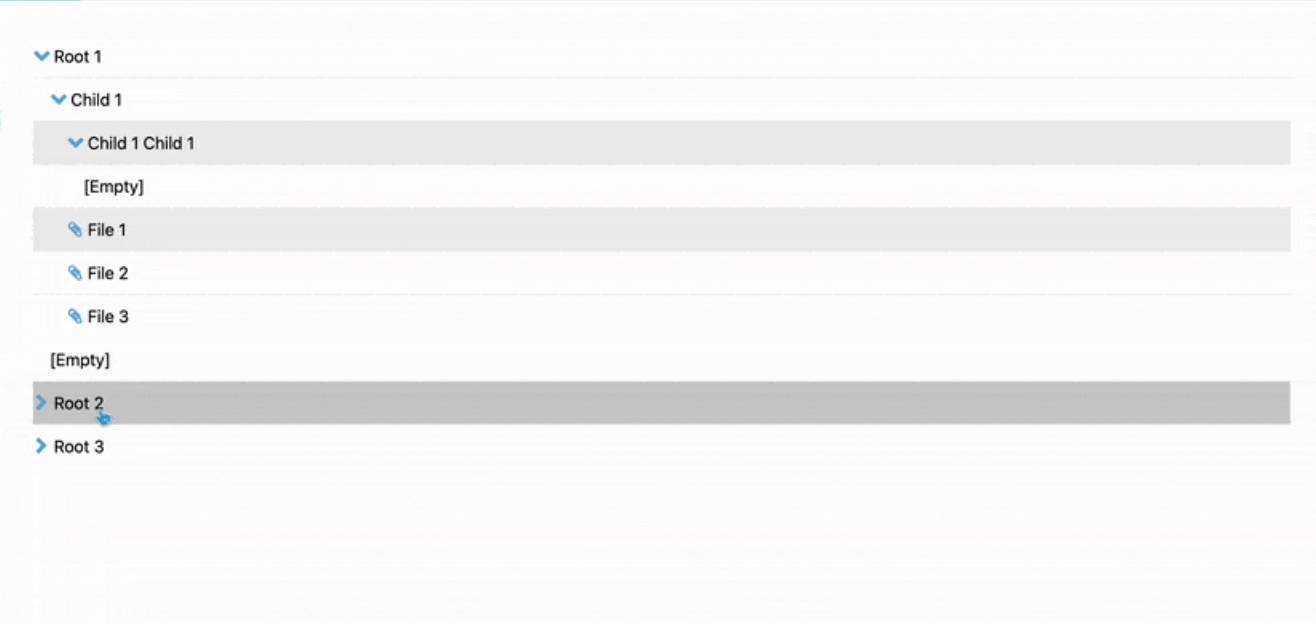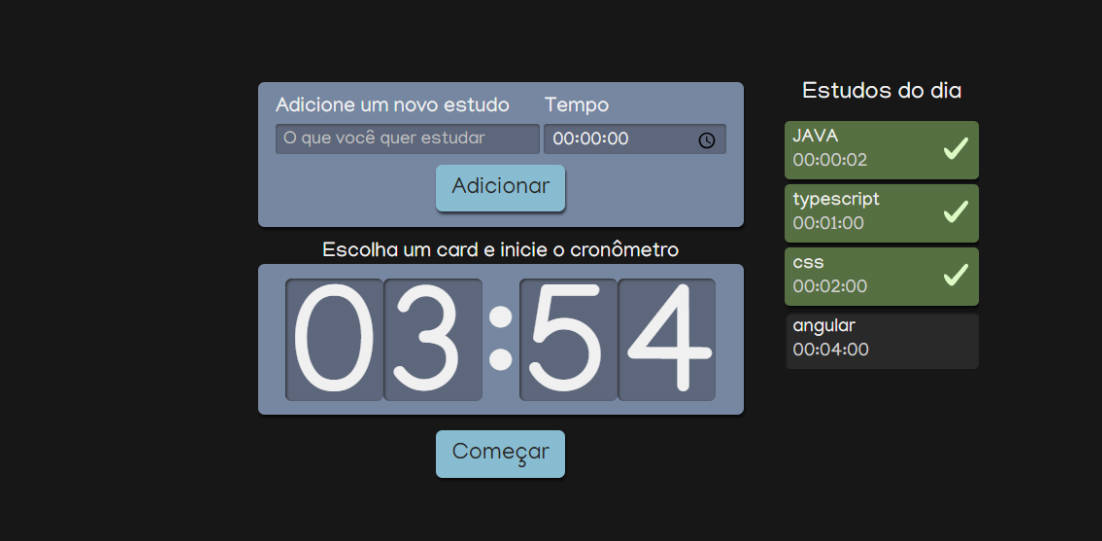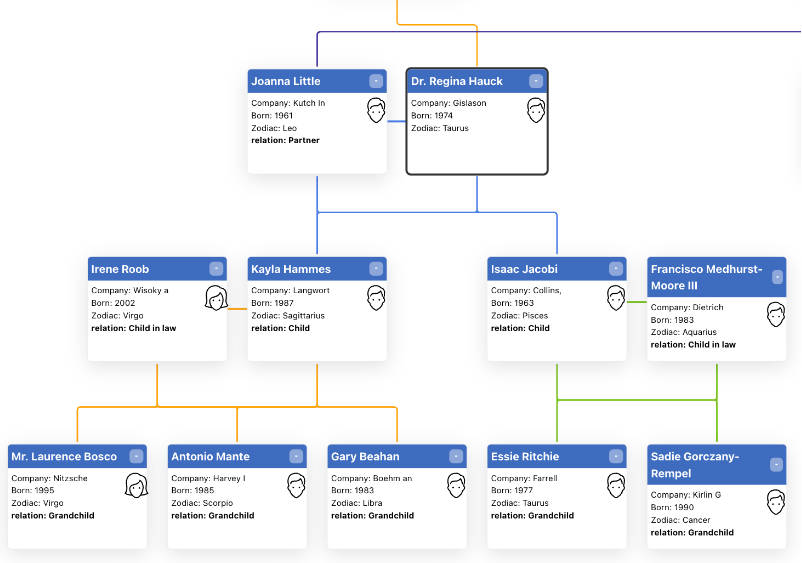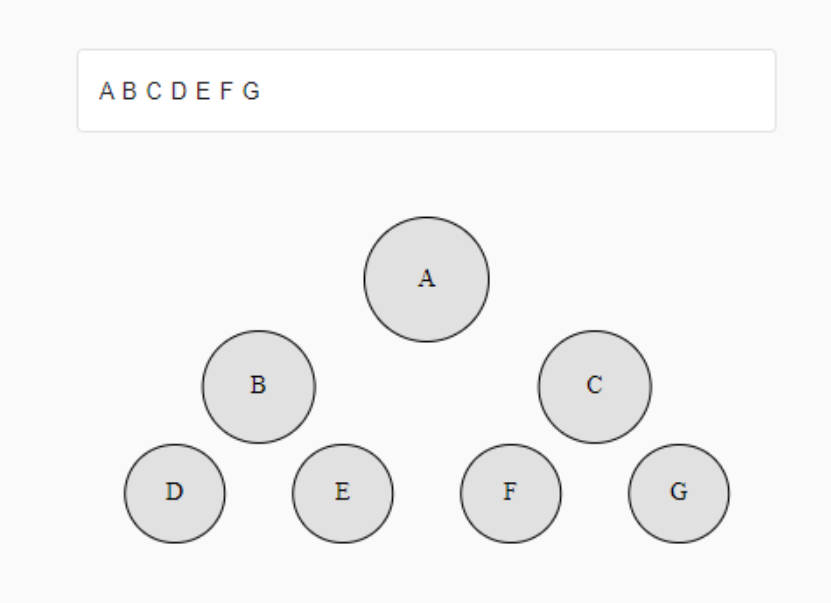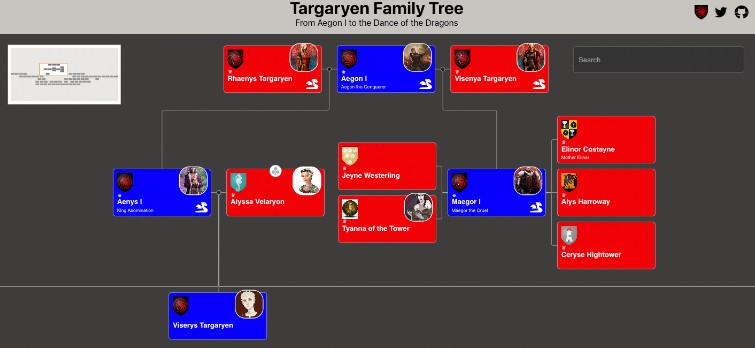react-tree
a hierarchical tree component for React in Typescript

Features
- Written in Typescript will full typings exported from package
- Theming support for almost all parts of the components appearance, (NEW including partial theming) (see Theming below)
- Use as an uncontrolled component with
defaultSelectedNodesanddefaultOpenNodesor a completely controlled component withselectedNodesandopenNodesprops withonEventlisteners - Fully stylable container for fixed width, or flex-box based layouts, or scrollable container when lists are too long for the parent container
- Optimized UX to clearly indicate open/closed folders, selected items and feedback on user input
- Toggle support for long-object labels with
truncateLongTextprop - Title attributes on hover for truncated labels that are too long for container
- Toggle support for empty folders with
displayEmptyprop - Customizable component message strings with
messagesprop (no data, empty folders, loading) - Display a loading indicator and nothing when in loading state with
loadingprop - Opt-in animated micro-interactions for opening/closing folders
- Multi-select API! hold your OS’s
metakey orctrlkey to be able to select/deselect multiple-nodes - NEW in v3 imperative API via export
useReactTreeApihook. Pass the ref to the componenta (see Imperative API below - NEW in v3 new context-based state management for better maintainability and handling of business logic
- NEW in v3 moved
react-domandstyled-componentstopeerDependencies - NEW in v3 Custom render functions for nodes and icons (full node context passed to render function with open/selected status)
Add to a project
yarn add @naisutech/react-tree or npm install @naisutech/react-tree
Usage
There is only one required prop: nodes (see Data format)
import { ReactTree } from '@naisutech/react-tree'
// component code
const data = ... // fetch data
<ReactTree nodes={data} />
Data format
- data should be a flat list of node
objectswith required properties:label,id,parentId
- optional properties:
items
idis typed to benumberorstring- root nodes should have
parentIdproperty set tonull - files/leaf items should be a flat list of node objects on
itemsproperty inside a node. - files do not require an
itemsproperty (this should be obvious) - example:
[
{
"id": 12345678,
"parentId": null,
"label": "My parent node",
"items": [
{
"id": 87654321,
"label": "My file",
"parentId": 12345678
}
]
},
{
"id": 56789012,
"parentId": 12345678,
"label": "My child node"
}
]
Component API
There are a number of optional properties which can be used to customise the UX of your React Tree component. You can explore the full interactive docs here or you can refer to the sample code below:
<ReactTree
nodes: TreeNodeList
defaultOpenNodes?: TreeNodeId[]
defaultSelectedNodes?: TreeNodeId[]
messages?: { noData?: React.ReactNode; loading?: React.ReactNode; emptyItems?: React.ReactNode }
loading?: boolean
theme?: string
themes?: ThemeSettings
enableItemAnimations?: boolean
enableIndicatorAnimations?: boolean
showEmptyItems?: boolean
noIcons?: boolean
truncateLongText?: boolean
containerStyles?: React.CSSProperties
RenderNode?: TreeRenderFn
RenderIcon?: TreeRenderFn
selectedNodes?: TreeNodeId[]
openNodes?: TreeNodeId[]
onToggleSelectedNodes?: (nodes: TreeNodeId[]) => void
onToggleOpenNodes?: (nodes: TreeNodeId[]) => void
ref: React.MutableRef<ReactTreeApi>
/>
Props list
| Prop name | Prop type | Default | Required | Description |
|---|---|---|---|---|
nodes |
TreeNodeList |
[] |
Y | The data set for react tree to render |
defaultOpenNodes |
TreeNodeId[] |
undefined |
N | The default set of open nodes. Specify when you intend to use the component in uncontrolled mode |
defaultSelectedNodes |
TreeNodeId[] |
undefined |
N | The default set of selected nodes. Specify when you intend to use the component in uncontrolled mode |
openNodes |
TreeNodeId[] |
undefined |
N | The currently open nodes. Specify when you intend to use the component in controlled mode. |
selectedNodes |
TreeNodeId[] |
undefined |
N | The currently selected nodes. Specify when you intend to use the component in controlled mode. |
theme |
string |
light |
N | The curently selected theme (built-in themes are light, and dark) |
themes |
ThemeSettings (Record<string, ReactTreeTheme>) |
{} |
N | The user-specified set of themes |
loading |
boolean |
false |
N | Display a loader instead of the rendered tree |
messages |
{ noData?: React.ReactNode; loading?: React.ReactNode; emptyItems?: React.ReactNode } |
{loading: 'Loading...', noData: 'No data to render ?', emptyItems: '[Empty]' } |
N | The default component message strings. |
enableItemAnimations |
boolean |
false |
N | Whether or not to animate folders on enter/exit |
enableIndicatorAnimations |
boolean |
false |
N | Whether or not to animate folder open/close icons |
showEmptyItems |
boolean |
false |
N | Whether or not to display an indicator for empty folders |
noIcons |
boolean |
false |
N | Disable the icon display |
truncateLongText |
boolean |
false |
N | Prepares all DOM nodes to be able to truncate long text nodes. Note this setting will have no effect if container is not styled to have a fixed width. |
multiSelect |
boolean |
false |
N | Component is single select by default. |
containerStyles |
CSSProperties |
{} |
N | Style the React Tree container |
RenderNode |
TreeRenderFn |
undefined |
N | A custom renderer for Node elements. See Custom rendering |
RenderIcon |
TreeRenderFn |
undefined |
N | A custom renderer for Icon elements. See Custom rendering |
onToggleSelectedNodes |
(nodes: TreeNodeId[]) => void |
() => void | N | A callback called whenever items are selected/deselected |
onToggleOpenNodes |
(nodes: TreeNodeId[]) => void |
() => void | N | A callback called whenever items are opened/closed |
Typescript
React Tree is written in typescript and is fully typescript compatible. All type definitions are exported directly from the library. See src/types in the repo for extensive definitions
Imperative API
React Tree exposes a hook useReactTreeApi which you can use to imperatively control the tree component. The hook returns a React.MutableRef<ReactTreeApi> type object. All you have to do is pass the returned object to the ref props on the React Tree component. The .current property on the ref object will be populated with the API functions you need to fully control the component.
Usage
import ReactTree, { useReactTreeApi } from "@naisutech/react-tree"
const App = () => {
const treeApi = useReactTreeApi()
return <div>
<button onClick={() => { treeApi.current.toggleAllNodesOpenState("open") }}>Expand all</button>
<ReactTree
nodes={[]}
ref={treeApi}
/>
</div>
}
Docs
Full details of the React Tree API:
interface ReactTreeApi {
getOpenNodes: () => (number | string)[] // get a list of all open nodes
getSelectedNodes: () => (number | string)[] // get a list of all selected nodes
toggleNodeSelectedState: (node: string | number) => void // toggle a node selected/unselected. This is an inclusive operation (all other selected nodes are retained)
toggleNodeOpenState: (node: string | number) => void // toggle a node open. This is an inclusive operation (all other open nodes are retained)
toggleAllNodesOpenState: (state: 'open' | 'closed') => void // open or close all nodes
toggleAllNodesSelectedState: (state: 'selected' | 'unselected') => void // select or deselect all nodes
toggleOpenNodes: (nodes: (number | string)[]) => void // toggle a set of nodes open. This is an additive operation (it's a union of already open and newly open nodes)
toggleClosedNodes: (nodes: (number | string)[]) => void // toggle a set of nodes closed. This is an subtractive operation (it's a difference of already open and newly closed nodes)
toggleOpenClosedNodes: (nodes: (number | string)[]) => void // toggle a set of nodes open. This is an exclusive operation (all other open nodes are closed)
selectNodes: (nodes: (number | string)[]) => void // toggle a set of nodes selected. This is an additive operation (it's a union of already selected and newly selected nodes)
deselectNodes: (nodes: (number | string)[]) => void // toggle a set of nodes deselected. This is an subtractive operation (it's a difference of already selected and newly deselected nodes)
toggleSelectedNodes: (nodes: (number | string)[]) => void // toggle a set of nodes selected. This is an exclusive operation (all other selected nodes are deselected)
}
Theming
ReactTree supports custom theming. All values are CSS compatible properties. Provide the custom theme object to the themes prop (with a key matching your theme name) and provide your theme name to the theme prop.
Theme API:
Note all props are optional. Any props not provided will use initial settings (e.g. background-color: initial;)
interface ReactTreeTheme {
text?: {
fontSize?: SizeUnit | CSSUnit
fontFamily?: string
color?: string
selectedColor?: string | null
hoverColor?: string | null
}
nodes?: {
height?: CSSUnit
folder?: {
bgColor?: string
selectedBgColor?: string
hoverBgColor?: string | null
}
leaf?: {
bgColor?: string
selectedBgColor?: string
hoverBgColor?: string | null
}
separator?: {
border?: string
borderColor?: string
}
icons?: {
size?: CSSUnit
folderColor?: string
leafColor?: string
}
}
}
Usage:
const myThemes: ThemeSettings = {
{
"exampleCustomTheme": {
"text": {
"fontSize": "xl",
"fontFamily": "cursive",
"color": "#fafafa",
"selectedColor": "#fafafa",
"hoverColor": "#fafafa"
},
"nodes": {
"height": "3.5rem",
"folder": {
"bgColor": "gold",
"selectedBgColor": "goldenrod",
"hoverBgColor": "yellow"
},
"leaf": {
"bgColor": "magenta",
"selectedBgColor": "blueviolet",
"hoverBgColor": "violet"
},
"separator": {
"border": "3px solid",
"borderColor": "transparent"
},
"icons": {
"size": "1rem",
"folderColor": "crimson",
"leafColor": "white"
}
}
}
}
}
<Tree nodes={data} theme="exampleCustomTheme" themes={myThemes} />
Result

Custom render functions
React Tree includes two props RenderNode and RenderIcon which can be used to fully customize the appearance and behaviour of the component
### API
Icons and nodes both use the same API, TreeRenderFn:
type TreeRenderFn = ({
node,
type,
selected = false,
open = false,
context
}: {
node: TreeNode
type: 'leaf' | 'node' | 'loader'
selected: boolean
open?: boolean
Icon?: React.ReactNode
context: TReactTreeContext
}) => React.ReactNode
node: TreeNode– the node datatype: 'leaf' | 'node' | 'loader'– the type of this nodeselected: boolean– indicates whether node is selected or notopen: boolean– use only for node, indicates whether node is open or noticon: React.ReactNode– the SVG component of the original React Tree icon if you want to use itcontext: TReactTreeContext– the entire React Tree context including the state, and API methods
Nodes
ReactTree will call (if provided) the RenderNode icon with the API for TreeRenderFn. This should be enough information to render any customization you need.
N.B. if you use the prop truncateLongText you’ll notice that unless you properly style your custom node elements, it will take no effect. As explained elsewhere, you’ll need to make sure that a) the container is styled to have a fixed width and b) that the custom node is styled overflow-x: hidden; and text-overflow: ellipsis to be rendered correctly.
Icons
ReactTree comes with a pretty solid set of default icons for showing node elements and leaf elements. However, if you want to hide the icons, pass the noIcons prop.
If you want to customize the icons, you can! Some conditions:
- the icon is rendered inside a container which whose size is determined by theme property
icons.size. It will render any child SVG orimgelement as100%height and width within that container
TODO in v4 and beyond
- add drag and drop support
Contributing
- open issues and PRs and we’ll work together!
